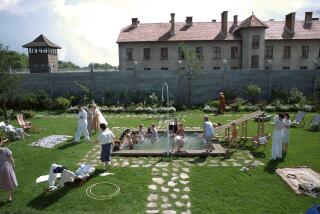A new convert to Berlin’s charms
- Share via
Berlin — I just returned from a long weekend in Germany’s once divided capital, and I have been converted. My sister, Martha, who came with me, had been telling me that Berlin was the most interesting city in Europe. But I live in Paris so I didn’t believe her.
The flight from Paris to Schonefeld Airport, a budget airline hub on the east side of Berlin, takes 90 minutes. Once we landed, I took the airport express train to Friedrichstrasse station, just south of the River Spree, in what was East Germany until 14 years ago.
Outside, I passed a fast-food stand called Checkpoint Curry, crossed the river on the Weidendammer Bridge, with its cast-iron imperial eagles, and stopped to gawk in the Berliner Ensemble theater, where Bertolt Brecht served as director. Like much of the former East Berlin, the neighborhood had an edgy, uneven look: elegantly restored apartment buildings next to decrepit ones, pretty parks shoulder to shoulder with trash-strewn vacant lots.
Finally I reached the Hotel Kunstlerheim Luise, where the rooms were designed by different Berlin artists. Martha and I shared a double, which had hollow, life-size wooden feet in variously colored socks attached to the white walls. We weren’t sure what the decor meant, but we grew to like it. Fortunately, we also grew accustomed to the rumble of trains crossing elevated tracks just outside our windows.
That morning, Martha gave me a quick tour of the city’s greatest monuments. First we walked by the Reichstag, Germany’s 1894 Neo-Renaissance parliament building. Its futuristic glass dome, designed by British architect Norman Foster, opened in 1999.
Then I got my first look at the majestic Brandenburg Gate, a triumphal arch for Prussian King Frederick William II, heavily damaged in World War II, rebuilt in 1956 and bounded by the Berlin Wall when communist authorities drew a line in concrete between East and West Berlin in 1961.
No city I can think of bears its scars and shares its hopes as bravely as Berlin. At almost every turn, we felt the pathos of history and the dazzle of the future. Just beyond the classically proportioned Brandenburg Gate, Martha and I stopped at the DZ Bank building. Its architect was the unconventional Frank O. Gehry, and it seems surprisingly buttoned-up -- until you see the massive, amoeba-shaped brushed-steel-and-wood sculpture that lies within its glass atrium.
Not so long ago, the block south of the Brandenburg Gate was an empty lot. Now it is the setting of Berlin’s almost-completed Memorial to the Murdered Jews in Europe, a rolling field of tombstone-like blocks designed by American architect Peter Eisenman.
We took a cab along the southern side of the Tiergarten, Berlin’s central park, to the busy shopping district along Kurfurstendamm, home of the Kaufhaus des Westens department store, affectionately known as KaDeWe. Its seventh-floor gourmet food court ranks among Martha’s favorite Berlin places, a veritable Flemish still life of comestibles. Here we lunched on plump oysters in cheese, cream and wine. Afterward, we took a train to Hauptbahnhof station, another mammoth work in progress, which will boast a curving glass roof maintained by high-tech cleaning robots when it’s finished in 2010.
It’s just a few blocks from the Hamburger Bahnhof museum, which is showing Friedrich Christian Flick’s landmark collection of contemporary conceptual art, including apple-headed figures with big pink genitals created by California artist Paul McCarthy and an oddly delightful garden sculpture full of paint cans, potted plants and old TVs by German artist Dieter Roth.
The collection is contentious because it was bankrolled by what some have called “blood money,” amassed by Flick’s grandfather Friedrich Flick, an industrialist who was convicted at Nuremburg of using slave labor during World War II. He served three years of a seven-year sentence and went on to amass another fortune. At his death in 1972, his worth was estimated at $1 billion.
We saw all this on the first day. The next morning, Astrid Williams, a friend of Martha’s who lives in Berlin, took us for a walk in the Mitte district, part of the old Soviet sector and, before that, home to Berlin’s Jewish quarter.
This was a different Berlin from the one we’d seen the day before. We strolled in the funky neighborhood around Hackescher Markt, with its hot cafes, restaurants and bars, such as Cibo Matto on Rosenthaler Strasse. Nearby, we lunched on spicy Asian noodles at the Indonesian eatery Monsieur Vuong.
Afterward, we walked to the old, overgrown Jewish cemetery and Koppenplatz, a square with a park, where we stood by “The Abandoned Room,” a sculpture by Carl Biedermann and Eva Butzmann evoking the persecution of Berlin’s Jews.
We had a quiet, excellent dinner that night at Lutter & Wegner, one of Berlin’s oldest brasseries, in the elegant Gendarmenmarkt section of town, and spent the next morning wandering past food and souvenir booths in the Tiergarten, set up to celebrate Unification Day, which marks the events set in motion by the 1989 fall of the Berlin Wall. Then we said goodbye at infamous Checkpoint Charlie.
I know I need to come back so I can deepen my understanding of one of the world’s most complicated, volatile cities. But for now, I like the idea of having seen Berlin from Checkpoint Curry to Checkpoint Charlie.
Susan Spano also writes “Postcards From Paris,” which can be read at www.latimes .com/susanspano.
More to Read
Sign up for Essential California
The most important California stories and recommendations in your inbox every morning.
You may occasionally receive promotional content from the Los Angeles Times.










